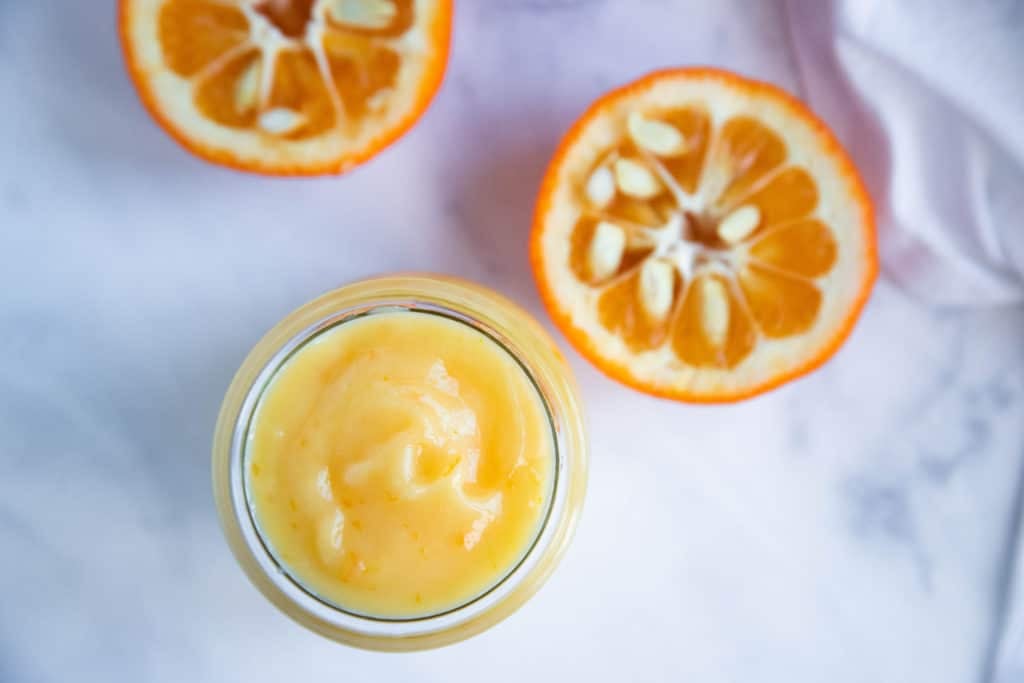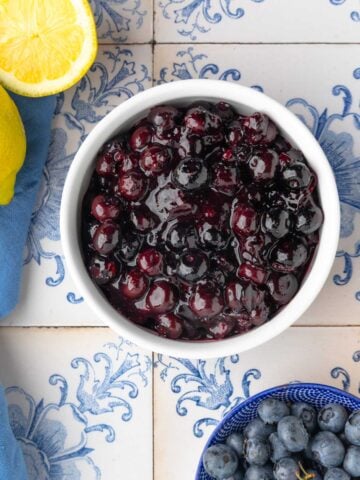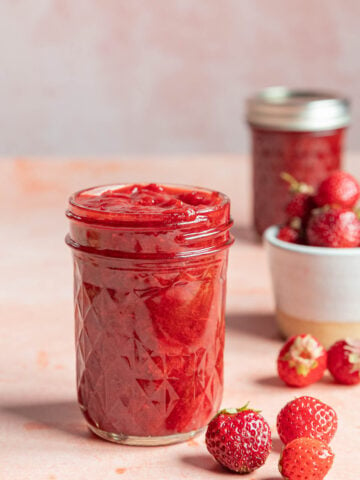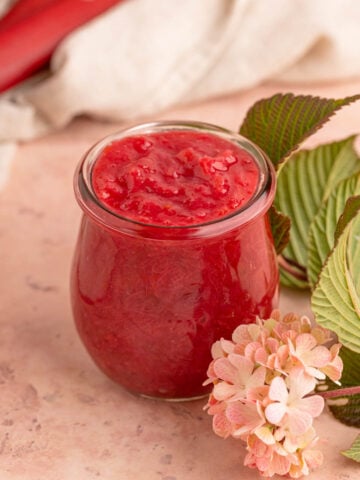I am on a quest to make as many different fruit curds as I can and this Seville Orange Curd is the latest addition. Fruit curd is a luscious, tart, creamy fruit spread. So far I have made lemon, kumquat, strawberry, cranberry, and rhubarb curds. My favorite to date was the lemon curd, but I love the taste of this Seville Orange Curd. The flavor is amazingly intense and reminds of my favorite sour candy growing up. See my tips below for making curds with other types of oranges.

Jump to:
Why This Recipe Works
Seville Oranges are too tart and sour to be eaten straight, but they make a delicious jam and as it turns out an amazing fruit curd. The tartness of the fruit pairs well with the sugar, butter and eggs in a traditional curd to make a creamy and tart dessert. Plus the natural pectin the fruit ensures that the final curd will be nice and thick - perfect for a cake filling.
The Curd Ingredients
The basic recipe for this Seville orange curd consists of four ingredients:

- Seville Oranges
- Orange Zest
- Whole Eggs and Egg Yolks
- Unsalted Butter
- Granulated Sugar
As you can see the seeds are huge therefore it will take about 5 oranges to get the right amount juice.
The orange zest is from regular navel oranges for flavor, appearance and because the zest of navel oranges is not as bitter. Orange zest is the thin outer skin of the orange and contains the oils that carry a flavor of the fruit. Use a microplane to zest the fruit and be careful to only zest the green part not the white bitter pith.
Eggs are used to thicken the curd. The combination of sugar and eggs is needed for thickening and butter makes it extra creamy.
What Are Seville Oranges
Seville Oranges are a sour or bitter orange. They are perfect for citrus fruit curd because while the pulp is too sour to eat raw, it packs a flavor punch and the natural pectin ensures a thick creamy curd. Seville oranges get their name from the city of Seville, Spain where they are a symbol of the city.
The oranges have a very short season. They are normally available from late December until the end of February. I did a little research and found that the oranges freeze well, so if you find some buy a few extra for use later in the year.

How to Make Seville Orange Curd
Curd is made on the stovetop on medium heat and whisked constantly. Do not walk away from the curd while you are cooking it or it will burn. When the curd has thickened and reached the right temperature strain it to remove any solids (little bits of cooked eggs and the zest) so it is extra smooth.
The right temperature is listed to ensure that you have cooked the curd enough, and that you don't accidentally boil it. Boiling curd will cause it to curdle and create a grainy texture.

The directions call for a non-reactive saucepan, which is a pan that will not react with the acid in the oranges. Do not use an aluminum pan, use stainless steel. Using an aluminum pan will produce a metallic taste.
The curd is chilled immediately to keep bacteria from forming. The surface of the curd is covered with plastic wrap to keep a skin from forming on the surface of the curd.
How Long Can Fruit Curd be Refrigerated
The Seville orange curd will be good in the refrigerator for up to 3 weeks and can be frozen up to one year. If you freeze it, allow it to thaw in the refrigerator about 24 hours before you're ready to use it.
Serving Options
- Use it as a topping for pancakes, waffles, ice cream, yogurt, cheesecake, other cakes and even just plain toast.
- Use it as filling for layer cakes, tarts, crepes or sandwich cookies.

Fruit Curd - Frequently Asked Questions
Yes, you can use navel oranges if don't have Seville orange. Regular orange juice is not as intense in flavor as Seville oranges, so start with 1-1/2 cups of fresh-squeezed orange juice and boil it down to 3/4 cup to intensify the flavor.
If your curd is still runny then you probably didn't cook it long enough.
Yes. If you are allergic to dairy you can make the curd without butter. It will be a little less creamy, but still taste delicious.
No, you cannot make the curd without eggs. Eggs are a signature ingredient of fruit curds. Eggs thicken the curd and provide the creamy texture.
Other Fruit Curd Recipes
For other delicious fruit curds and recipes using fruit curd, check out these recipes on the blog:
I hope you try this recipe for this intensely flavored Seville Orange curd. If you do make it please leave a comment here on the blog or tag me on Instagram @bakesbybrownsugar with a picture of your version.

Want to Save This Recipe?
Enter your email below and I'll send it to your inbox. Plus get new and recommended recipes sent to you every week!
By submitting this form, you consent to receive emails from Bakes by Brown Sugar.

Seville Orange Curd
Ingredients
- 3/4 cup (180 ml) fresh-squeezed Seville Orange juice
- 2 large (100 grams) whole eggs
- 4 large (80 grams) large egg yolks
- 1 cup (200 grams) granulated sugar
- 1/8 teaspoon kosher salt
- 8 tablespoons (113 grams) unsalted butter room temperature
- 2 teaspoons navel orange zest
Instructions
- Place a strainer over a medium-sized bowl near the stove.
- Juice the oranges until you have 3/4 cup juice.
- In a stainless steel 3 or 4-quart saucepan, Whisk together the whole eggs, egg yolks, sugar, and salt until well blended. Whisk in the orange juice and add the butter and salt.
- Cook the mixture over medium heat, whisking constantly until the mixture is thickened. As you cook the mixture the butter will melt. When the mixture has thickened and reached a temperature of 185°F pour it into the strainer. Press the curd through a fine-mesh strainer to remove the solids.
- Zest a medium navel orange directly into the curd and whisk the zest into the orange curd.
- Cover the surface of the curd with plastic wrap, gently pressing the plastic wrap onto the surface of the curd. Place the curd in the refrigerator and chill.
Storing the Orange Curd
- The Seville orange curd is good in the refrigerator for 3 weeks and can be frozen for up to 1 year. If freezing the curd, package it in a freezer container after it has chilled. When ready to use place it in the refrigerator to thaw for 24 hours before its intended use.






sallybr says
The cut oranges are so beautiful! I doubt I would find them where I live, so I will have to settle for regular oranges... (sad)
Kathleen says
This is really yummy! Hard not to just eat it all with a spoon!! Turned out perfectly, and great, easy to follow instructions. Am thinking about using the whites to make a pavlova and fill with the curd and fresh fruit.
Cheryl Norris says
Hi Kathleen
Thank you for visiting the blog. I'm so glad you liked the Seville Orange Curd. And thank you for letting me know the instructions are easy to follow. I strive to write good recipe directions so I appreciate your feedback. It made me smile. If you make the pavlova I would love to see pictures.
Sharon says
I made your Seville lemon curd recipe from a wild orange tree in the woods in my back yard and it came out beautiful. I used Monkfruit instead of sugar to cut down on calories. I have more oranges I’ve put in the freezer for now and will making another batch soon.
Cheryl Norris says
Hi Sharon
Thank you for trying this recipe! I'm so glad you enjoyed it. And thank you for the information on the monkfruit - that is such a good idea. I learn a lot from my readers.